Research Reports / Rapports de recherche
Selective Memories and the Material World:
The Changing Significance of the Warren B. Shepard Site, Battle Creek, Michigan
1 Battle Creek, Michigan, is one of the most famous cities of its size in the Great Lakes region, if not in all of North America (Fig. 1). Its name recognition, of course, is derived from the breakfast food that millions of people throughout the world wake up to daily — cereal. Corn flakes and Grape Nuts are the legacies of the Kellogg brothers and C. W. Post who laid the foundations for the cereal industry in the early twentieth century.1 To commemorate the role that breakfast foods played in the community's prosperity and to promote their continued importance, the Kellogg Company sponsored the recently opened (June 1998) "Cereal City" museum. Local interest in heritage preservation has been sporadic in the past, however. For example, whereas John Harvey Kellogg served as the President of the Historical Society of Battle Creek (HSBC) in 1927, numerous historic buildings have been lost to urban development throughout the twentieth century.
2 One of the surviving landmarks of the Cereal City is the Warren B. Shepard house (20CA104), the site of recent historical archaeological investigations by students and faculty from Western Michigan University (Figs. 2 and 3). The site and its associated landscape, which is dominated by a mid-nineteenth century two-story brick Greek Revival house, came to our attention in 1994 soon after it was acquired by the HSBC. Documentary studies of the site began in 1995 and were followed by field investigations in 1996 and 1998.2 The research project endeavoured to understand how landscape changes since the early nineteenth century express significant transformations in class, gender, and ethnic relations among the occupants of this former farmstead.
3 As an exercise in historical archaeology, a variety of different sources have been consulted and methodologies used from an interdisciplinary perspective. For example, we have employed geophysics to detect subsurface deposits, analysed material remains from our excavations, consulted documents, and interviewed local informants to develop a more complete picture of the built environment at this site.3 By doing so we were forced to confront how the myriad sources relate to one another, how individuals and groups create an understanding of their pasts, and how the past is used in the present.4 This paper explores the ways in which memory and identity are intertwined with landscape at the Shepard site and how the community's collective memory of the site is connected to local and national history.
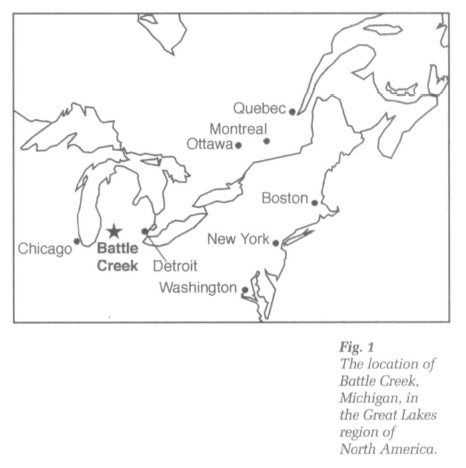 Display large image of Figure 1
Display large image of Figure 1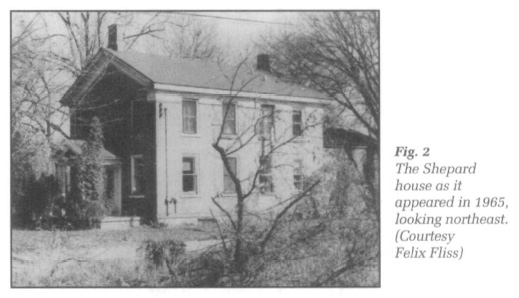 Display large image of Figure 2
Display large image of Figure 2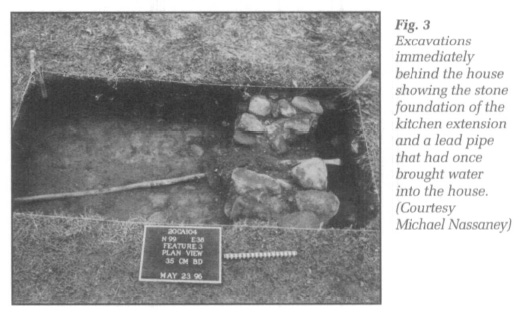 Display large image of Figure 3
Display large image of Figure 3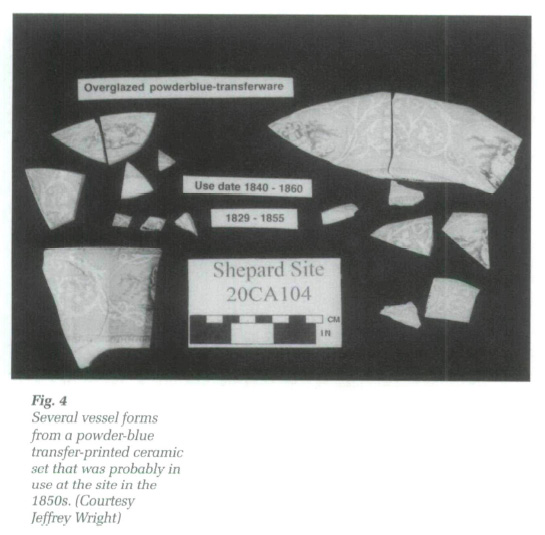 Display large image of Figure 4
Display large image of Figure 44 The site's namesake — Warren Shepard — has long served as an icon of the importance of education in the pioneer period. When the house first came to our attention, we immediately learned that it was the home of Battle Creek's first schoolteacher. Despite the association of the house with this pioneer, we have come to realize that the significance of the house has waxed and waned over the past 147 years and has obviously had different meanings for various segments of the population through time. Thus, the house is a symbol whose meaning has been transformed by its occupants as they modified it and altered its landscape in the process of creating and reproducing their social identities. In addition, as community identity was transformed from pioneer town to industrial centre, the meaning of the house for local viewers also changed. In this paper we: (1) detail the methodologies that were used to reconstruct landscape from memory and material remains; (2) suggest how these changes are sensitive indicators of class and ethnic relations; and (3) interpret how the changing significance of the house is reflected in the narrative histories associated with the community and the nation.
Historical Background
5 A detailed historical overview of the city of Battle Creek or an analysis of the significance of the architectural and landscape modifications to the property is beyond the scope of this paper.5 Instead, we will highlight how the memories of one of our oldest informants provide evidence for changes in the class and ethnic affiliations of the occupants who moved into the house after the Shepards and how the house's symbolic meanings are tied to changes in community and national identity. But first, we present some brief background information on the historical context of the Shepard site, its occupants, and the physical layout of the farm-stead beginning in the early nineteenth century.
6 Battle Creek was first surveyed in the 1820s, settled by pioneers in 1831, and incorporated as a city in 1859.6 It was located along a branch of Territorial Road, a major nineteenth-century transportation route that connected Detroit with Lake Michigan, Chicago, and other points to the west (Fig. 1). The early pioneers recognized the need for a schoolteacher on the frontier, and invited Warren B. Shepard, a native of Aurora, New York, to join their community in 1834.7 While nearly all references to Shepard in local histories recount these facts, very few indicate and none emphasize that he only taught school children for less than two years before becoming involved in a brick-making partnership and eventually full-time agriculture.8 To sustain his 120-acre farm in the 1840s, Shepard was assisted by his wife, Almeda, a number of hired hands, and the addition of several children by the 1850s. He slowly transformed the wilderness to suit his needs and likely constructed several out-buildings to facilitate agricultural production, which had become his primary activity.
7 Shepard's most significant capital investment came in the early 1850s when he used approximately $2,000 he was awarded for damages in a lawsuit to begin construction of a brick Greek Revival farmhouse (Fig. 2). Details of the house and recovered artifacts dating to this period indicate a significant change in socio-economic status from his earlier years. Shepard was an active participant in the consumerism of the age.9 He used material goods such as matched ceramic place settings to signal his arrival into the emerging middle class and express his new social identity (Fig. 4). Historical records, particularly an account book that he maintained during this period, indicate that the site also took on the appearance of a nucleated farmstead during the 1850s.10 Newly constructed features include one and possibly two large barns, pens, a walkway, a garden, and fences, as well as possibly a spring house, meat storage facility, and storage cribs.11 Moreover, the spatial efficiency of these landscape features conformed to the principles of a new economic order based on "competition, market orientation, capital accumulation, and profits."12 Buildings and activity areas were located to streamline and systematize movement in the hopes of minimizing excessive energy and waste. Outbuildings may have also been placed in proximity to the house to facilitate the surveillance of hired hands that Shepard needed to run his farm.13
8 This progressive ideal of spatial order and efficiency was not confined to the farm but also had its expressions in industry as well as in the home.14 For example, the farmhouse was divided "into two parts, one oriented toward the farm, the other to the public"15 (Fig. 5). The design of the house interior served to transform and reinforce new class relations in society and gender relations within the household. Male and female spheres were created and reinforced through behaviors in the home, and extended onto the surrounding landscape.
9 Despite Shepard's death in 1876, the property was maintained as a working farm until the late nineteenth century when his daughters, Emily and Amanda, and relatives of uncertain status, John Shepard and his family, occupied the house. The daughters are listed in the 1880 federal census as "boarders" in the house that was their father's. Their sworn testimony that they were the legal heirs to the property, and the fact that the estate was not taken to probate court until 1897, suggests that there may have been a dispute, likely from John Shepard, over the ownership of the property.
10 In any event, Amanda and Emily established ownership and witnessed two significant developments in Battle Creek at the turn of the century that would have immediate and long-term consequences for the community along with international repercussions. In the 1860s the Seventh Day Adventist sectarian movement founded the Western Health Reform Institute in Battle Creek to promote a healthy lifestyle.16 Dr John Harvey Kellogg became medical director in 1876 and expanded the facility into one of the world's most renowned institutions for health reform, known as the Battle Creek Sanitarium. In the early years of this century, the "San," as it became known, attracted celebrities and dignitaries from all over the world.
11 An important element of the dietary regime at the San was the avoidance of alcohol, meat, and stimulants such as coffee and tea. An outcome of the search for a healthy, tasty, and easy to prepare breakfast food for Sanitarium patients/clients, was the invention of flaked cereal in the early 1890s.17 Charles Post, a one-time visitor to the Sanitarium, also took up cereal production in 1896 and quickly turned a profit, creating a veritable cereal boom as many would-be competitors flocked to Battle Creek in the early years of the twentieth century.18 Although most cereal ventures were undercapitalized and subsequently failed, the Kellogg and Postum companies were remarkably successful and have made an indelible imprint on the landscape and economy of Battle Creek.
12 One of the early failed competitors, the World's Fare Food Company, purchased all but 4 of the original 120 acres of the Shepard farmstead in 1902 from Amanda and Emily. This sale effectively put an end to the family farm and ushered in a period of land sub-division that characterized many areas of the United States in the early twentieth century.19 Soon after Amanda Shepard died in 1919, her sister moved from the house and began renting it (circa 1920) to an Italian immigrant family who later purchased and occupied it until 1935. Over the next fifty years, the house served as a duplex rental unit until 1985 when a new owner began to rehabilitate the house for commercial use. The house was abandoned when these preservation efforts failed, and the site was soon after acquired by the HSBC. The purchase was motivated by the fact that the house is one of the oldest and finest brick Greek Revival structures still standing in the city and, perhaps more importantly, the home of Battle Creek's first schoolteacher.
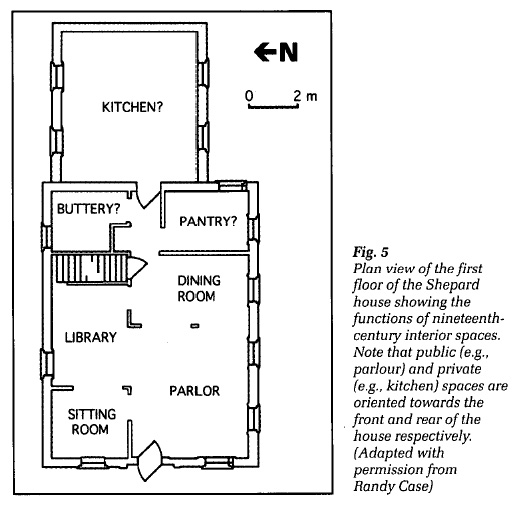 Display large image of Figure 5
Display large image of Figure 5Theoretical and Methodological Approaches to the Study of Landscape, Memory, and Identity
13 The study of the Shepard site was conducted under the auspices of the Southwest Michigan Historical Landscape Project. The Project is an initiative that uses historical, archaeological, and ethnographic methods to document the spatial organization of gardens, houses, barns, and fences associated with historic home lots in southwest Michigan. It was designed and implemented through collaboration between students and faculty at Western Michigan University in 1994 to explore the social meaning of the built environment.20 Theoretically, landscapes are political-economic outcomes; studies have shown that men and women, rich and poor, native and immigrant build their cultural environments and organize space in ways that serve to create, reproduce, and transform their social identities.21 In historic America, Battle Creek notwithstanding, social relations were codified through the material world and these material texts of social action can often be read in ways that differ from verbal and written records. Indeed, this approach has application in various cultural and historical contexts.
14 Historical archaeology — the study of the development of the modern world with the aid of historical documents — is by definition multidisciplinary.22 The study becomes interdisciplinary when practitioners are able to weave together information on social relations, artifacts, and the built environment from various sources including documents, informants, geophysics, and archaeological remains. None of these sources need be given priority; each should be used as a cross check against the other in an attempt to gain a better understanding of areas of source complementarity and ambiguity. This interpretive dynamism is mirrored by the dynamics of landscape features and their spatial arrangements. In this study, oral accounts led us to interrogate other data sources to better understand the connections between landscape, memory, and identity.
15 It is important to note that data collection and analysis constitute only one aspect of the study. Another important direction has been the effort to inform the community about our findings through public interpretation and to invite public participation. For example, the HSBC sponsored an open house that attracted nearly two hundred visitors to our excavations in 1996 during Preservation Month (May). Somewhat fortuitously, this proved to be a very useful way to meet former residents of the house who shared old photos and recollections of architectural and landscape changes. Public lectures in the community and media coverage have also served to disseminate some of our results, and to bring community interpretation and understanding of the house to our attention.
Discussion
16 What lessons can we draw about the relationship between material and narrative history from our excavations, documentary research, and discussions with numerous neighbours and occupants of the house? What linkages exist between landscape, memory and identity at the home of Battle Creek's first school-teacher? As James Deetz and likely many other scholars have noted, "memory is a funny thing."23 Memory is a highly subjective medium, yet still significantly different from photographs, artifacts, or other traces of the past. Unlike other relatively static depictions of the past, a memory records an event or scene based on the personal experience of the viewer and can be altered and even erased (that is, forgotten) over time as the viewer's perspective on the significance of the event changes. Moreover, memories have an extremely limited temporal scope, and even if recorded much is lost with the individual's death.
17 In our discussions with community members, we obviously encountered no one who had ever met Warren Shepard or his wife, Almeda (d. 1868), nor anyone who remembered the site when it was a working farm. The pioneer period of the early and mid-nineteenth century is romanticized in most writings and in the minds of contemporary residents as a time when people endured great hardships and toiled long days in search for a better life.24 The move from a log cabin to a more refined structure such as Shepard's Greek Revival home often marked the beginning of that better life, though only those who were fortunate enough to accumulate sufficient capital to allow entry into the emergent middle class experienced this prosperity. Many were excluded as exemplified by the labourers whom Shepard employed.25 While the landscape of the farmstead surely evolved during this period as improvements were made, there are no conspicuous standing buildings that can easily remind us of its former appearance. Nevertheless, the house is a relatively permanent landmark that exhibits distinctive nineteenth-century attributes such as the classic Greek Revival form, labour-intensive dentillated woodwork, and heavy entablature at the eaves. Archaeological remains and architectural clues also point to the later addition of various features such as a clinker driveway and Victorian porches in the late nineteenth century that once served to modernize the property.
18 The house has clearly been a collective symbol for the community at various times in the past. Creating a shared history, and a sense of movement through a shared present toward a shared future, is very important in the formation of corporate groups, such as cities and nations.26 This may explain the emphasis in early histories on Warren Shepard as the first schoolteacher; and the importance accorded to this house as his house, despite its construction nearly two decades after his teaching career had ended. When the population of Battle Creek was still physically and socially mobile, with many new residents arriving, it was important to mark the various community "firsts" of the Pioneer era in order to create a sense of community history and social solidarity.
19 As the community identity of Battle Creek stabilized, and class boundaries became more rigid, it was no longer necessary to tell those stories that forged a community history. In their place, the story of cereal and the international renown of the Battle Creek Sanitarium became the dominant narrative of local history. In contrast, the Shepard site, which was relatively disconnected from this narrative, faded with the community's first hand memories of the Shepard family. More recent recognition of the house as one of the oldest standing brick structures in Battle Creek underscores the materiality of the house as a unique physical monument of this era, rather than the people who once occupied the site. This is a different kind of community history, one which projects a sense of a long — and in many ways faceless — history.27 The erasure of the significance of the Shepard site was probably accelerated and facilitated in the early twentieth century as the landscape, and the house itself, was altered by successive owners, beginning with the Meaccis, to something barely recognizable in nineteenth-century terms.
20 The first quarter of the twentieth century was probably the most active period of landscape change at the site since the mid-nineteenth century when the house was originally built. By 1900 the focus of the household, which comprised only two members (Amanda and Emily Shepard), had shifted away from being a primary site of agricultural production. Amanda and Emily Shepard began to sell off the land holdings that their father had willed them, setting in motion the process of land subdivision. The message that their father, Warren Shepard, had sought to project through the symbolism of the Greek Revival style had long since faded. The relations of power and authority that the building once represented to hired hands and passersby had little meaning for twentieth-century viewers. Moreover, subsequent occupants would use the landscape to express themselves in radically different ways. By the 1920s when the Italian-born Meaccis moved in, the built environment was well on its way to signaling a new set of social relations.
21 One of our first clues to the significance of the structural transformations that occurred at the Shepard site in the 1920s were the comments made repeatedly by Mrs Mary Kline about her early recollections of the house.28 Mrs Kline, an octogenarian neighbour who visited the site in 1996, noted in no uncertain terms how beautiful the house was when Emily Shepard lived in it (late 1910s) and how the Meaccis, in stark contrast, had "ruined the house." While we were initially puzzled by these remarks, they have taken on a new meaning in the context of changes initiated by a shift in ethnic ownership.
22 When Emily Shepard last occupied the house, it was probably little changed from its late nineteenth-century appearance. The parlour and dining room in particular, parts of the house that Mrs Kline would most likely have been allowed to see and hence recollect, still had their original elaborate woodwork. Moreover, these rooms would have been cluttered with numerous Victorian furnishings that represented domesticity such as "knickknacks, books, live plants, ceramics, fancy needlework, and photograph albums," as well as hair wreaths in glass frames and large family bibles with decorative covers.29
23 By the time the Meaccis moved in, "the formality of Victorian life, with its elaborate codes of social etiquette" had come to an end.30 Moreover, these symbols had different meanings for the Meaccis, ones that they likely did not care to identify with or express. The Meaccis came to America with Old World tastes and attitudes towards furnishings and domesticity, or else attempted to adopt "American" ideals that by now tended toward "simplicity and naturalness in domestic architecture and interior design."31 In either case, it seems almost certain that the consumer choices of the Meaccis would have differed considerably from those of the Shepards.
24 Outside the house, these differences would have been even more apparent as passersby could view and interpret the landscape changes the Meaccis effected as they worked to make the old Shepard farmstead their own. Some of the cultural baggage that probably accompanied the Meaccis included beliefs associated with Italian feast days, ceremonies, games, and food consumption, some of the most enduring aspects of culture. In what we think was an attempt to reproduce the Old World in Battle Creek, the newcomers created yard spaces the likes of which Mrs Kline had probably never seen before. Photographs taken in the 1930s in the possession of Bruna Meacci Shafer, who was born in the house in circa 1923, depict two rows of grapevines planted by her father immediately north of the house. Between the vines was an area designated for bocce ball, "a game of Italian origin similar to lawn bowling played on a. long narrow usually dirt court."32 The vineyard surrounding the court would have lent a private, Old World atmosphere to the male bocce players as they enjoyed each other's company on a Sunday afternoon. This haven stood in marked contrast to the denuded agricultural landscape, encroaching neighbours, and the sounds and activities of the outside world. Evidence of the vines can still be seen today along the edge of the wooded lot immediately north of the house.
25 In addition, this small vineyard was probably established to produce grapes for homemade wine during the Prohibition Era of the 1920s and 1930s. The fragmentary base of what appears to be a wine bottle was recovered from our excavations in a temporal context that would support this interpretation.33 Mrs Kline's insistence that the Meaccis ran a speakeasy during Prohibition might stem from her observation of what the Meaccis probably considered traditional merry-making. Different perspectives, and the experiences of differing viewers and/or participants, illustrate the multiple meanings of events and landscapes.34 While Mrs Kline viewed these unfamiliar activities as another way in which the Meaccis were "ruining" the house, they probably saw these behaviors as "improving" the quality of life by creating more familiar and culturally consistent surroundings.
26 Another exterior change was the demolition of the north and south wooden porches that were likely in an advanced state of decay, having been constructed some thirty to forty years earlier. Their removal after 1931 may have coincided with the creation of a direct exterior entrance to the second floor on the north side of the house and/or the conversion of the kitchen extension into a garage. We have also identified a possible privy that was sealed with a trash deposit that dates to the first quarter of the twentieth century.35 An abandoned outhouse would be a suitable and convenient location to discard materials such as agricultural implements (for example, a pitch fork) and other antiquated objects (for example, a chamber pot, and a lamp chimney glass) that had been kept in an outbuilding, basement, or other storage space. The removal and discard of antiquated objects is often associated with cleaning activities conducted by new household occupants in an attempt to make various spaces (for example, sheds, barns, storage rooms, attics) available for new functions.36
27 There were undoubtedly continuities in land use patterns as well. For example, Silvano Meacci's daughter, Bruna (Meacci Shafer), recalls raising small animals such as chickens and rabbits, which may have been kept in pre-existing or newly constructed outbuildings behind the house to the east. As with the previous owners, the Meaccis were using spatial organization and material objects to express their social identity, though some modifications were radically different from what the neighbours had become accustomed to over the previous seventy-five years.
28 In addition to local narratives of history, it is also important for creating a national identity that local stories are embedded within a national discourse.37 This is evident in Battle Creek as local history is divided into conventional eras — brave pioneers, bright innovators, successful industrialists — and the significance of the Shepard house is neatly confined to one of these. However, the site is also connected to varying degrees with other aspects of this national story that are not currently emphasized in local memory. For example, Emily and Amanda Shepard sold much of their farmland to the World's Fare Food Company, a failed cereal venture, and the Meacci's are in many ways typical of the southern and eastern European immigrants who flooded the United States in the first quarter of the twentieth century. Yet, it is Warren Shepard who appears to communicate the most positive aspects of the national ideology, as reflected in commonly taught history, and it is his narrative that serves as a landmark for this site in local consciousness.
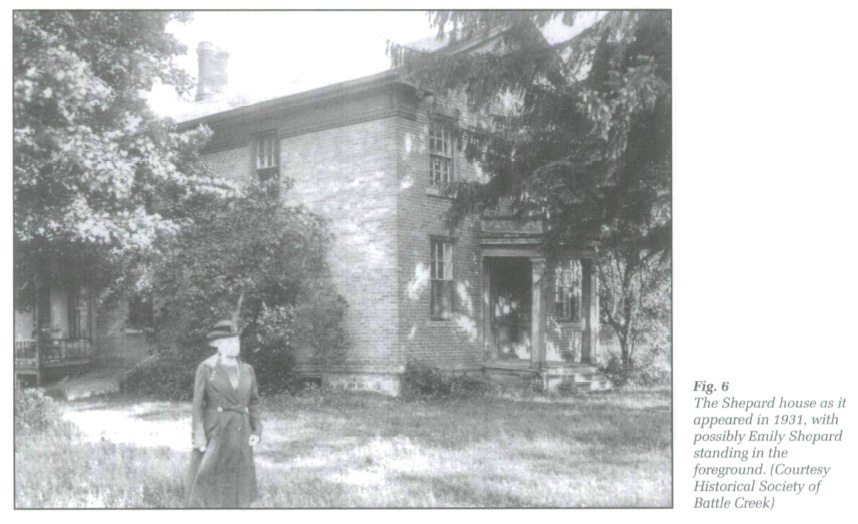 Display large image of Figure 6
Display large image of Figure 6Summary and Conclusions
29 When the city of Battle Creek was holding its centennial celebration in 1931, someone thought it appropriate to have Emily Shepard pose for a photograph on the lawn in front of the old family home (Fig. 6). Some residents of the community (probably members of the HSBC) still remembered and connected the significance of the house to Battle Creek's first schoolteacher. Few pioneer homes survived into the twentieth century, further underscoring the symbolic importance of the Shepard house. For other members of the community, such as Mary Kline, the house was merely a shell of its former self. Gone were the ornate interior furnishings, the exterior porches, and the "beautiful gate" that invited entry into Emily Shepard's garden. For Mary Kline, these cherished memories contrast so markedly with her recollections of the post-1920 landscape and its associated activities, particularly those related to alcohol consumption during Prohibition, that the latter were nothing short of illegal and perhaps un-American, if not uncouth. Clearly, Mary Kline's memories of the house were strongly tied to changes in landscape and the identities of its occupants.
30 As we try to raise local consciousness about the site, the local meanings of this house will probably change again. By designating the site as the home of the "first schoolteacher," the local community promotes what it values, or what local leaders want the community to value. Yet, messages regarding both the hard "pioneer days" and the altruism of the first schoolteacher — especially one who moved to the pioneer frontier town specifically to teach school — may potentially stand in opposition to the values and motivations of a multinational cereal industry and all that it represents. Efforts to preserve the house have been a way of saying mat there is more to Battle Creek, and its history, than cereal and health. Even so, an emphasis on the first schoolteacher itself overshadows the accomplishments of his two daughters in defending and maintaining their right to an inheritance as single women and of the Italian immigrants to whom they later sold the house. Bodi of these historical narratives, as well as those of earlier labourers on the farm and more recent tenants of the house, are also interesting dimensions of the history of Battle Creek.38
31 Somewhat sadly, the HSBC has recently decided to "deaccession" the house. The historic preservation of local landmarks becomes more and more difficult to promote as sponsorship declines in an era of corporate downsizing. In an increasingly privatized world, efforts are underway to sell or even give the house to a preservation-minded group or individual who is willing and able to restore it.
32 As historical archaeologists interested in the changing material dimensions of the Shepard house site, we have tried to provide a more balanced picture of the people who occupied the site over the past two centuries. By underscoring the idea that the house and landscape as they appear in contemporary life are products of political, economic, and social forces, we have succeeded in reminding a segment of the community that the house's historical significance extends beyond Warren Shepard. Moreover, some members of the community have taught us that history resides in their individual and collective memories and history is created through active engagement of agents whose motivations and visions will vary by class, gender, and ethnic identity. We have also identified other potentially interesting local narratives that can be told about the history of Battle Creek as a microcosm of nineteenth and early twentieth century America.
33 But in the end, these alternative narratives are only likely to attract the interest of active researchers and a small handful of listeners in the community. While bits and pieces of the past excavated from beneath the ground may help to illuminate a more complete history of the site, only those portions of the material record that fit into the local or national narratives will have resonance for the community. The challenge remains for historical archaeologists and other students of the past to present the results of their studies in such a way as to enter into the larger discourse of community and national concerns. If we are unable to achieve this, we may at least challenge the public to think critically about the past and how it contributes to local and national ideologies.39 Such efforts will go a long way towards explicating the linkages between memory, identity, and landscape — the props that serve to create and reproduce meaningful contexts for our everyday lives.
An earlier version of this paper was presented at the annual meeting of the Great Lakes American studies Association held at Miami University, Ohio, in March, 1998. Our work at the Shepard site was supported by the Miller Foundation, the Historical Society of Battle Creek, and the Anthropology Department of Western Michigan University (WMU). Our ideas about the site and its place in public history have benefited from discussions with Mary Butler, Daniel Sayers, Randy Case, Jeff McGovern, and members of the 1996 and 1998 WMU archaeological field schools. Finally, we thank the people of Battle Creek for sharing their history with us and allowing us to become partners with them in the stewardship of their pasts. We remain responsible for the interpretations presented here and hope that they promote a continuing awareness of the importance of landscape and memory in community histories and identity.